Walk Through History: Ostia Antica and Cerveteri - Portals to Rome's Ancient Past
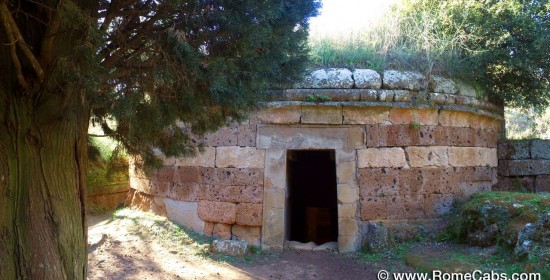
Buongiorno and welcome to Stefano’s RomeCabs, Rome’s top-rated company for tours in Italy and private excursions from Civitavecchia. In the heart of Italy, where the echoes of ancient civilizations still whisper in the breeze, lie two extraordinary archaeological wonders that transport you back in time to the splendors of Rome's past. Ostia Antica, the remarkably preserved ancient harbor city, and Cerveteri, an Etruscan gem, are featured on our exclusive "Ostia Antica and Cerveteri Tour from Rome".
In this comprehensive blog, we'll embark on a journey through time to these captivating destinations, uncovering the mysteries, treasures, and tales that continue to captivate visitors from around the world.
Walking Through History: Ostia Antica and Cerveteri
Portals to Rome's Ancient Past
Ostia Antica - The Harbor of Ancient Rome
Our voyage begins in the shadow of ancient Rome, at Ostia Antica, a city born from necessity that played a vital role in Rome's ascension.
In the 4th century BC, Rome found itself at a critical juncture. As the city's power and influence expanded across the Italian Peninsula, a thriving harbor became imperative. Thus, Ostia was born. Its name, derived from "os," the Latin word for mouth, was a fitting moniker for this harbor town strategically positioned at the mouth of the Tiber River.
Ostia quickly evolved into Rome's vital maritime lifeline. Its strategic location allowed the Roman Republic to efficiently transport supplies, including the crucial grain shipments from North Africa, which sustained the burgeoning city's population. This access to resources, facilitated by Ostia, was integral to Rome's ascendancy.
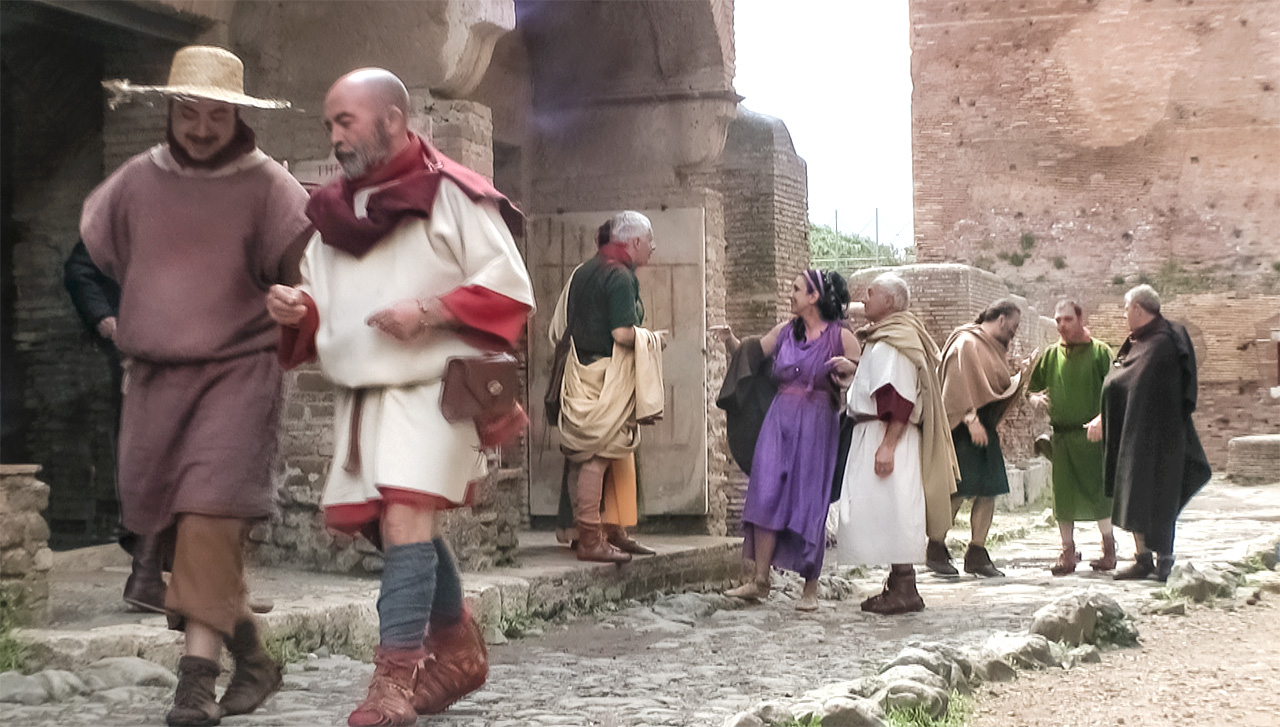
Ostia didn't merely serve as a conduit for goods; it was a gateway to the world. The bustling harbor welcomed people from diverse backgrounds, making it a melting pot of cultures. Greek, Egyptian, and Jewish communities thrived here, leaving indelible marks on the city's cultural mosaic.
Ostia wasn't just a transit point; it was a thriving urban center. Warehouses, mills, and workshops lined its streets, testaments to the economic vitality of the city. Visitors can still explore the well-preserved remnants of these commercial establishments, offering a glimpse into the bustling activity that defined daily life.
Ostia's significance endured over centuries. Even as the Roman Empire reached its zenith, the city remained pivotal, continuing to play a central role in trade and the spread of Roman influence. Its history is a testament to the adaptability and resilience of ancient civilizations.
Discover Ostia Antica's Archaeological Marvels
Step into the past as we explore the remarkably preserved ruins of Ostia Antica. Wander through its intricate grid of streets, marvel at its grand amphitheater, and uncover the secrets of its meticulously designed public baths. Discover the stories etched into the mosaics, frescoes, and inscriptions that adorn these ancient structures.
The Grid of Streets
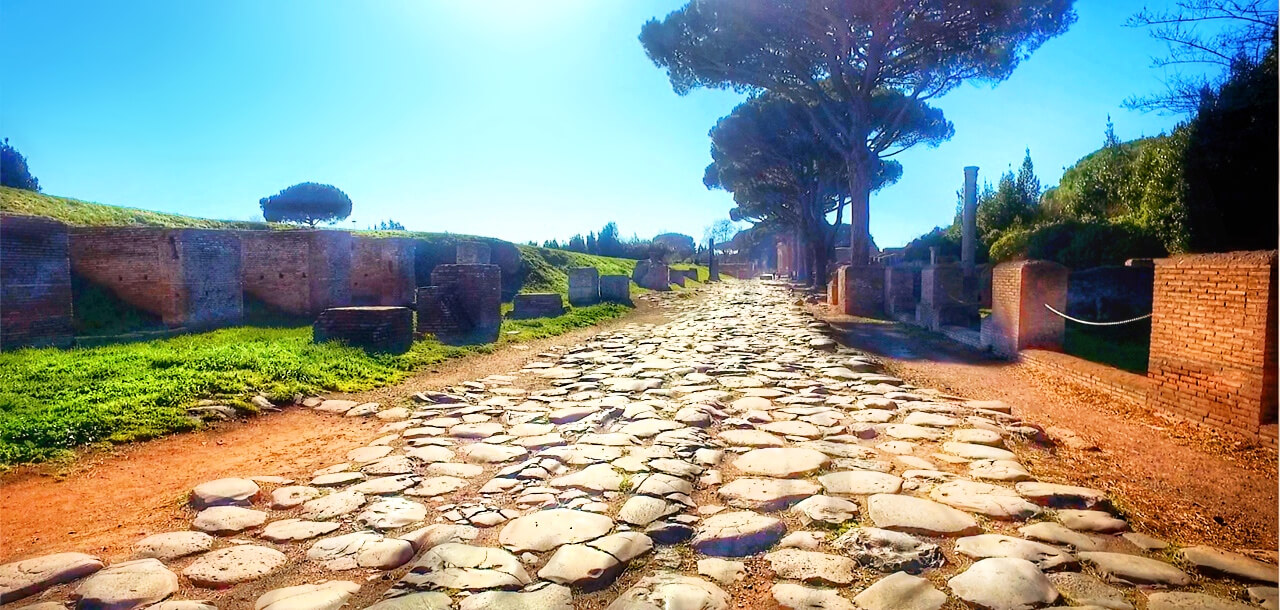
Walk in the footsteps of the Romans along the ancient Roads of Ostia Antica. The ancient city's urban layout is a testament to Roman engineering precision that they learned from their advanced predecessors, the Etruscans. Ostia’s grid of streets, replete with well-preserved cobblestones, offers a glimpse into the city's meticulous planning. One can also see the same layout when visiting Pompeii.
The intersection of Decumanus Maximus and Cardo Maximus serves as a remarkable example of this well-structured urban plan.
As you wander these ancient thoroughfares, imagine the bustling activity of merchants, traders, and residents going about their daily lives.
The Grand Theater
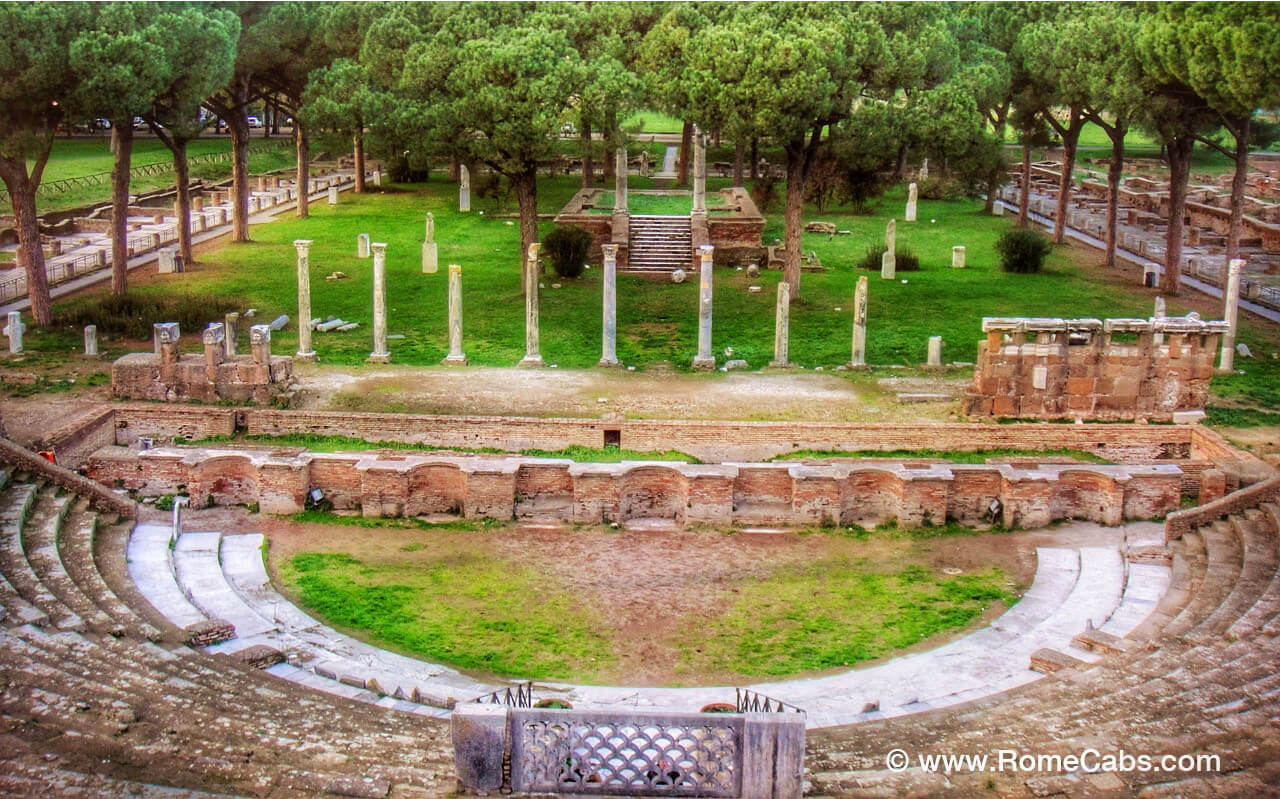
The Roman theater was an architectural marvel that stands as a testament to the grandeur of the ancient world. This awe-inspiring structure traces its origins back to the reign of Augustus in the late 1st century BC. Initially conceived as a magnificent venue capable of accommodating an impressive 2,500 spectators, it later underwent expansion in the 2nd century, elevating its capacity to a staggering 4,000 seats.
The theatre and its adjacent Piazzale formed a sprawling complex, a bustling center of commerce where the city's most esteemed merchants and traders conducted their affairs. Over the centuries, the structure bore the weight of time and underwent numerous renovations. Remarkably, it retains the very essence of its original allure, a cherished time capsule that continues to resonate with echoes from eras long gone by.
The Meticulously Designed Public Baths
The Baths of Neptune, an architectural masterpiece, reveal the Romans' obsession with communal bathing. Its soaring columns, elegant statues, and intricate floor mosaics offer a glimpse into the opulence and sophistication of Roman bathhouses. The various chambers, each with its specific purpose, reflect the meticulous planning that went into creating these social hubs.
The Mosaics and Frescoes
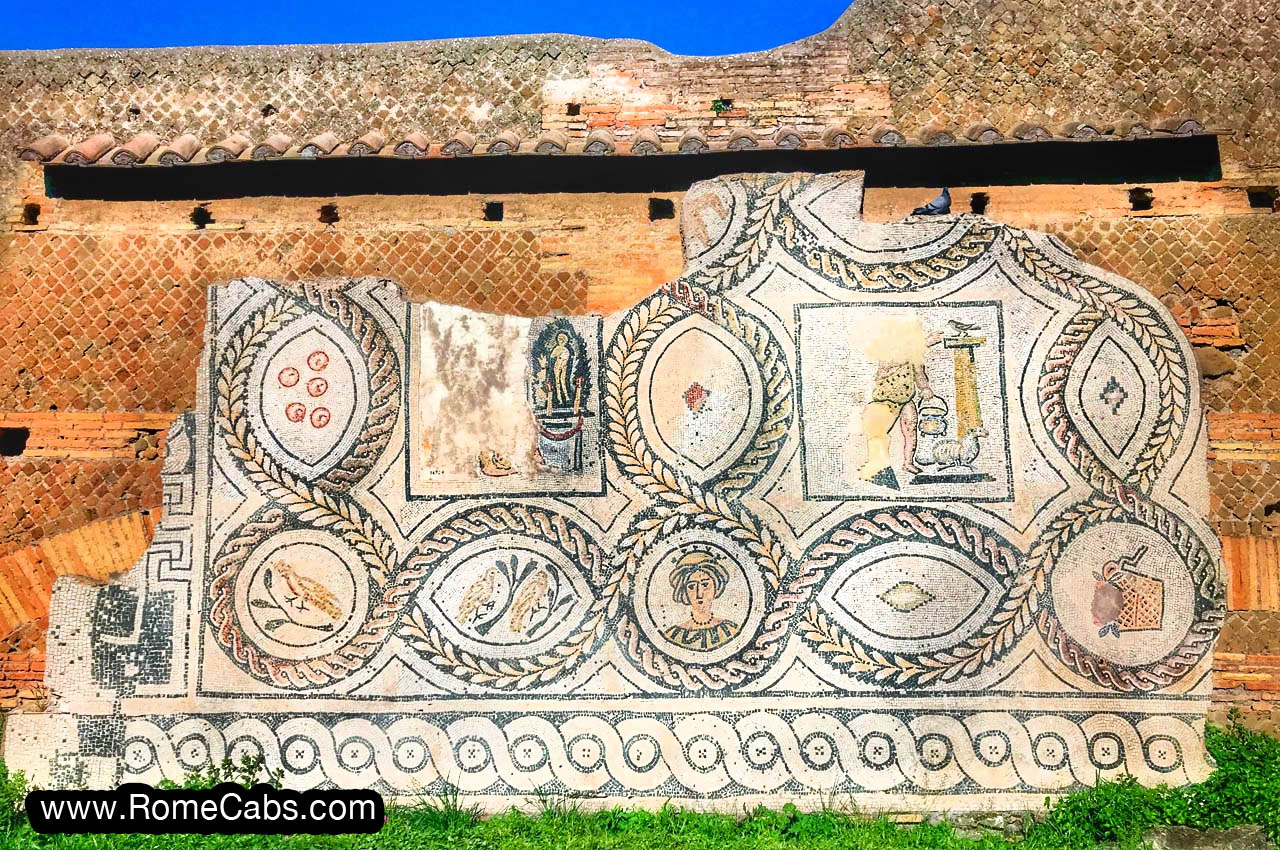
Ostia Antica boasts a treasure trove of artistry in the form of mosaics and frescoes. The House of the Masks, named for its striking mask-themed mosaics, is a prime example of the intricate craftsmanship that adorned the homes of Ostia's elite.
Mosaics of Villa of Perseus is a fourth-century polychrome mosaic that can be seen on an ancient wall.
The Thermopolium, an ancient fast-food joint, surprises visitors with colorful frescoes depicting its offerings, providing insights into the culinary tastes of the era.
The Thermopolium
The Termopolium and similar establishments were not only places to grab a quick meal but also social hubs. People from different walks of life would converge here, fostering conversations, trade, and a sense of community. In a way, these ancient fast-food joints were the predecessors of modern cafes and restaurants.
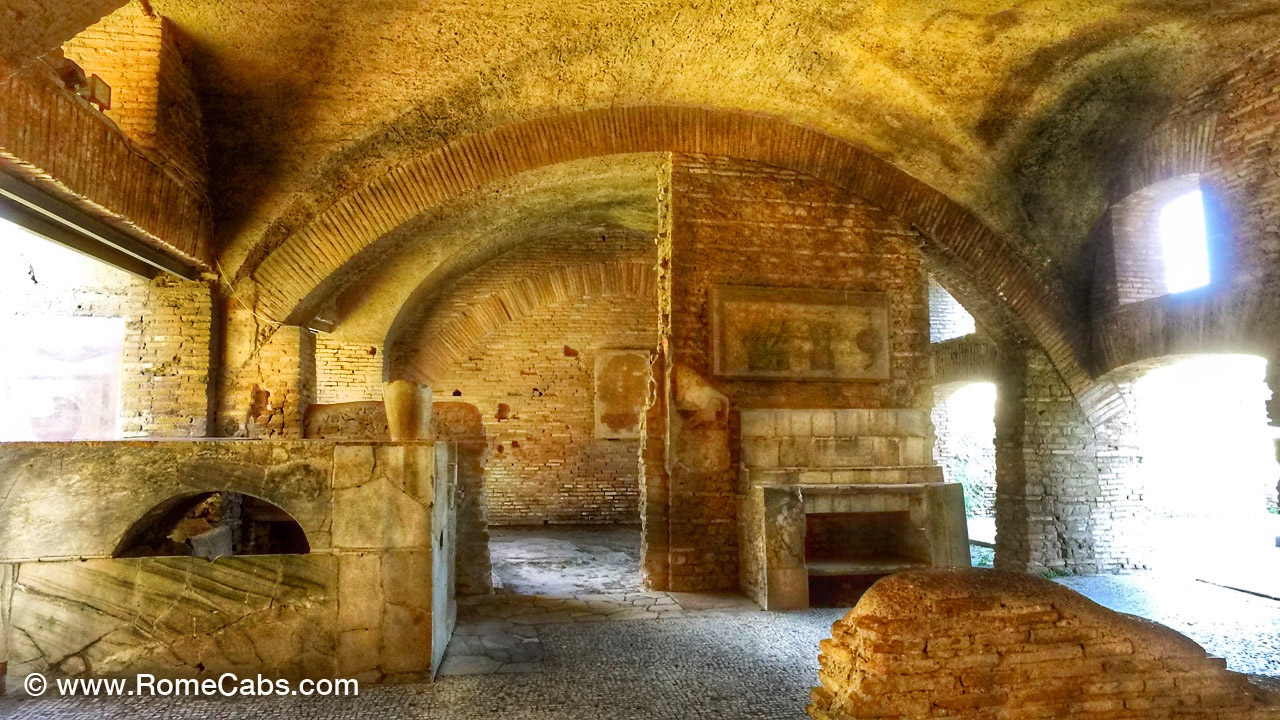
The Thermopolium consists of a long counter made of masonry, behind which the shopkeeper would have stood. This counter served as both a workspace and a display area for the food and drink offerings. The most distinctive feature of this particular Termopolium is its colorful frescoes.
These vividly painted images adorn the counter's front and depict various food items, such as fish, fowl, and other edibles. These frescoes not only provided a visual menu for customers but also added an aesthetic dimension to the establishment.
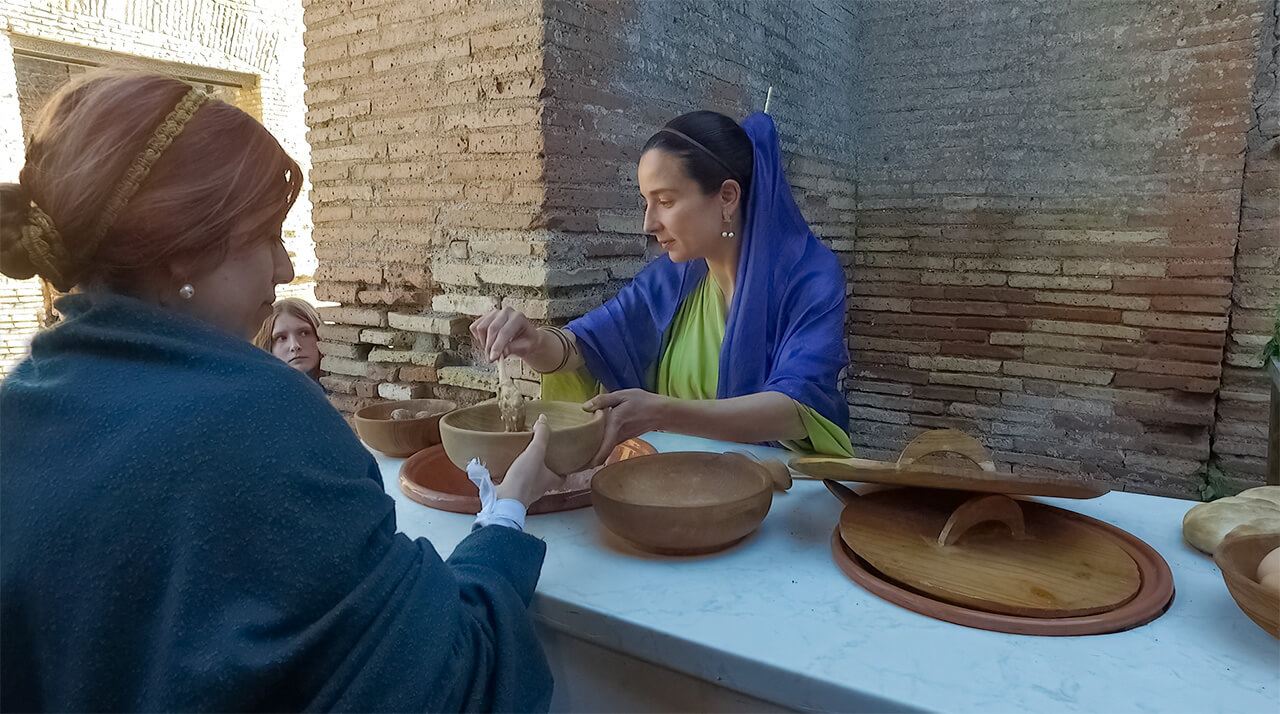
While specific details about the menu offerings at this Termopolium may remain a mystery, Roman thermopolia typically served a variety of hot and cold dishes. These could include stews, sausages, lentils, figs, eggs, and, of course, wine and other beverages.
Given Ostia's status as a major port, it's likely that seafood was also on the menu. Customers could purchase their selections and enjoy them on the spot or take them to go.
Unveiling Secrets in the Forum
The Forum of Ostia Antica served as the vibrant heart of the city, where the pulse of life resonated through its ancient streets. This forum was likely dedicated to Ancus Marcius, the legendary king of Rome (640-616 BC), and historical clues suggest the presence of a statue in his honor adorning the site.
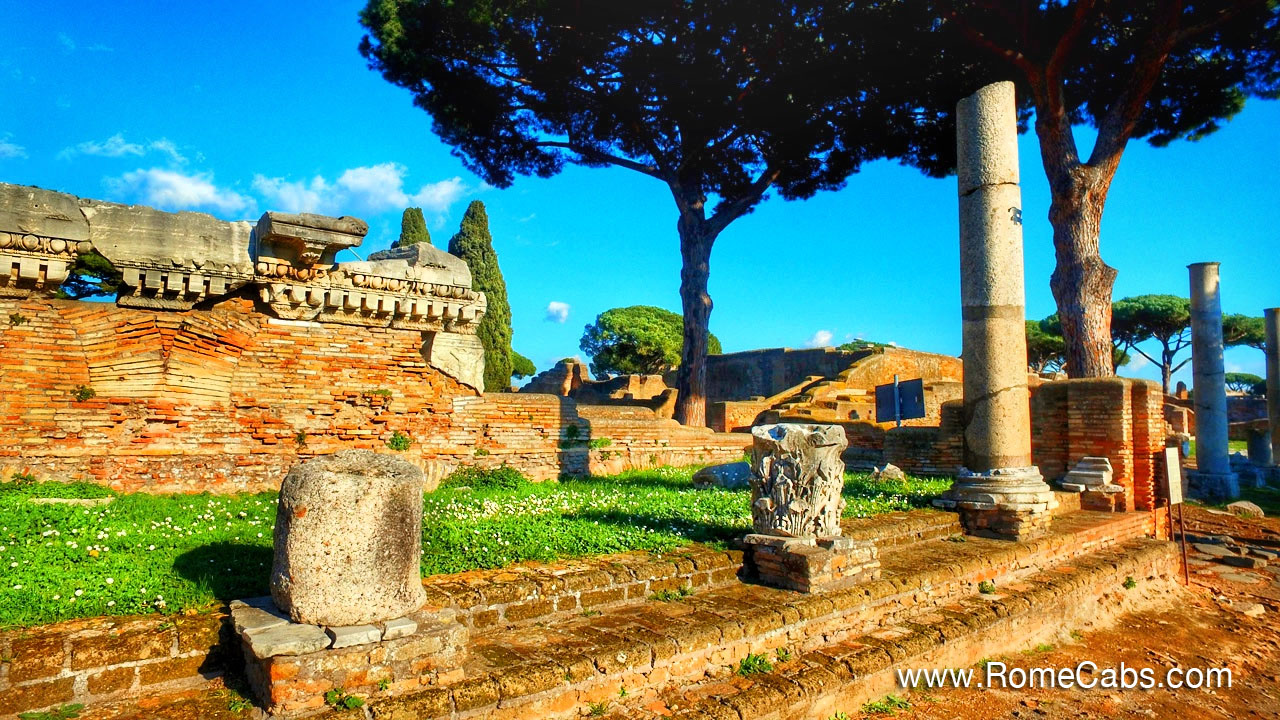
Within the forum's precincts stood several significant structures, including the Temple of Rome and Augustus, the Curia, the Capitolium, and the Basilica. The portico, its floor adorned with opulent marble, boasted an array of majestic granite columns.
To the northeast, three chambers were positioned near a staircase, while in the southeast, a niche housed a statue of significance. On the southwestern side, an array of shops lined the area. For chariots, the only feasible route traversed from east to west along the Decumanus Maximus, whereas north-to-south movement was primarily for pedestrians.
Piazzalle delle Corporazioni
The Piazzale delle Corporazioni, situated in the city's commercial district, dates back to the 2nd century AD, during the height of the Roman Empire. It was a vibrant hub of economic and social activity. It would have been a place where merchants, traders, and craftsmen gathered to conduct business, share information, and build professional networks.
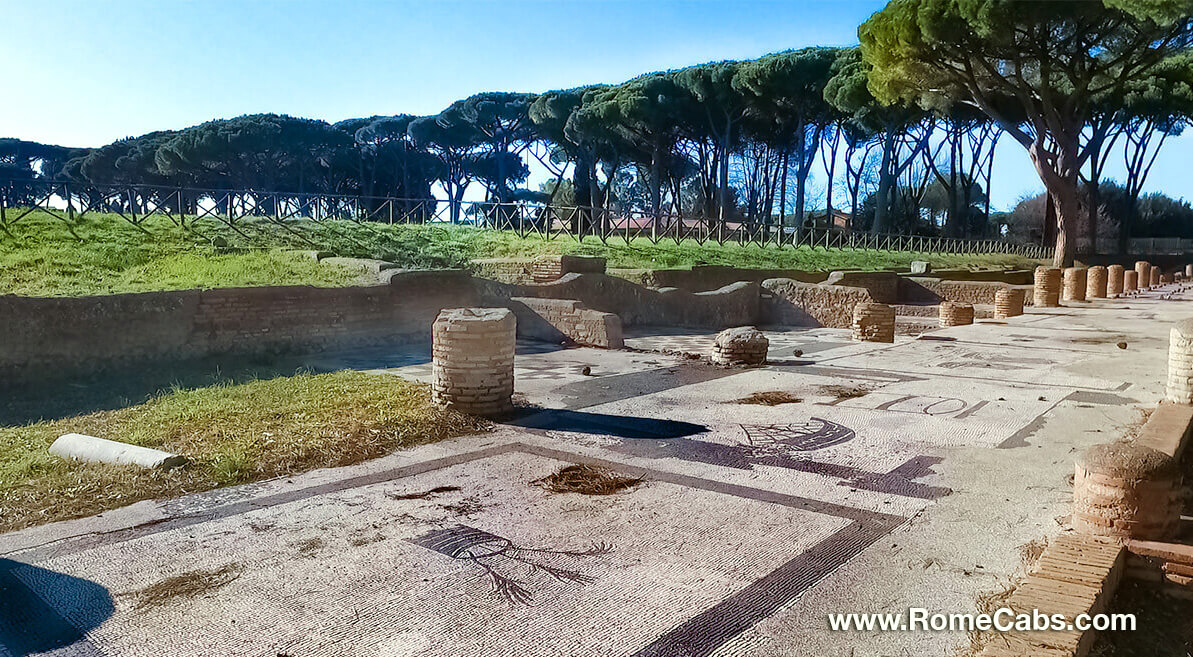
This plaza reflects the commercial diversity of Ostia, with different guilds catering to a wide range of trades and professions, from grain merchants to shipowners.
The Piazzale delle Corporazioni covers a substantial area behind the theater and consists of numerous rooms and small shops, all surrounding an open square. These rooms, referred to as "tabernae", were essentially small commercial stalls or offices. They had a range of functions, serving as places for trade, and storage, or even as offices for various guilds and corporations.
Ostia's Piazza of the Guilds earned its name due to the inscriptions and symbols found on the facades of these tabernae. These inscriptions, as well as mosaics on the floors, often included the names and emblems of trade guilds, merchant associations, and professional organizations. It's important to note that these guilds were not exactly like their medieval counterparts but served as social and business networks.
Insulae Diana and apartment dwelling in Ostia Antica
The Insulae Diana is situated within the archaeological site of Ostia Antica, close to the city's ancient harbor. This particular insula, like many others in Ostia, was a multi-story apartment building. The term "insula" itself means "island" in Latin, indicating the building's isolated nature.
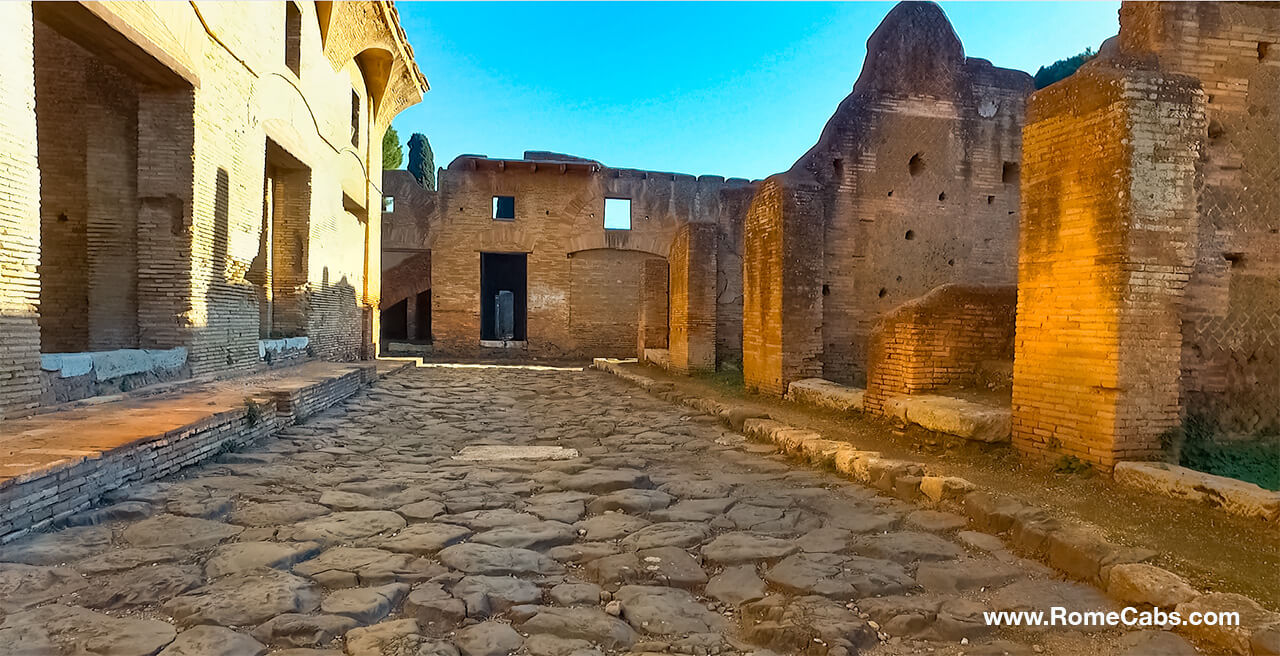
The Insulae Diana consisted of multiple stories, typically three to four, with individual living units or apartments on each level. The ground floor often housed shops, workshops, or taverns, while residential units were located above.
Insulae were typically tightly packed together, creating a sense of community among residents. However, the close quarters also meant that fires could quickly spread, posing a constant risk.
Life in these insulae varied widely depending on one's social and economic status. Wealthier residents might occupy larger and more comfortable apartments, while those of lower social standing might live in smaller, less desirable units. Sanitary facilities and running water were often limited, making daily life challenging for many.
The Lives of Ostia's Inhabitants
What was life like for the people who called Ostia home?
To truly understand the heartbeat of Ostia, we must step beyond the architectural wonders and venture into the lives of its diverse inhabitants. This ancient harbor town, like Rome itself, was a melting pot of cultures, traditions, and social hierarchies.
Life in Ostia was deeply intertwined with its role as a bustling harbor. The inhabitants' daily routines were choreographed by the ebb and flow of goods, as merchants from across the Mediterranean converged here. Warehouses, storehouses, and shops lined the city's streets, filled with exotic treasures like spices, silks, and wines.
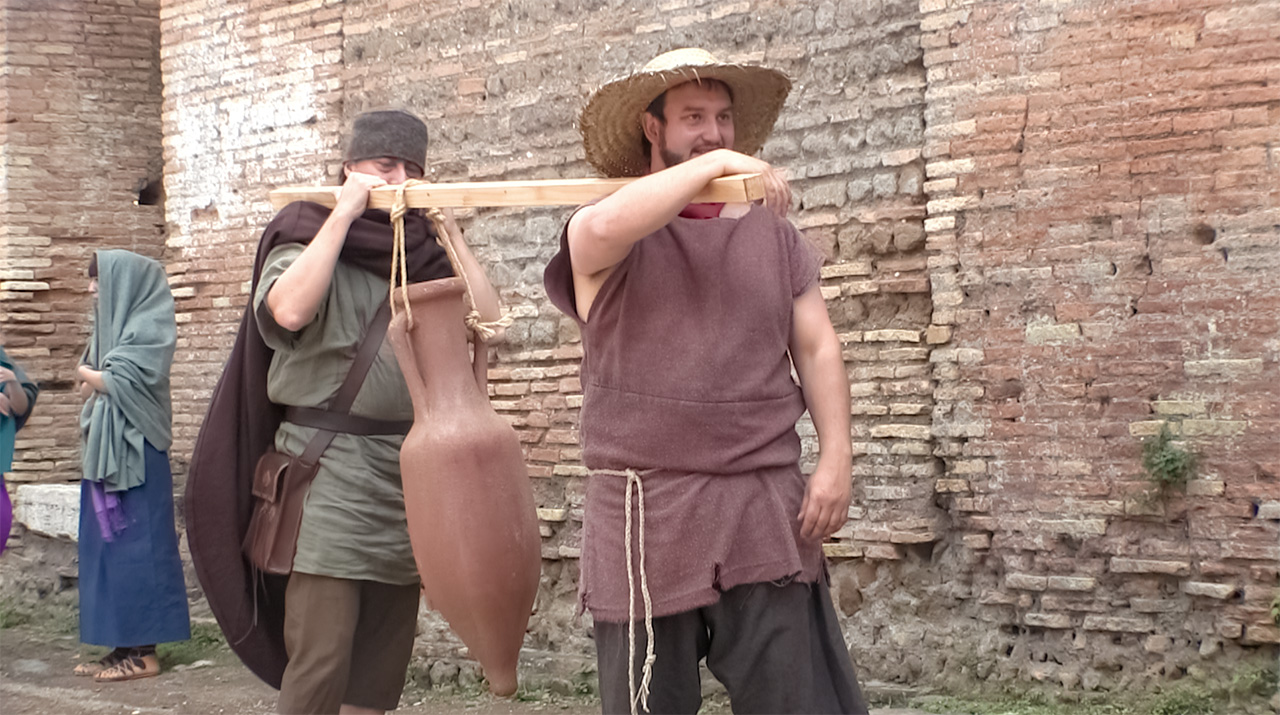
The Forum served as both a marketplace and a political center, where the clamor of commerce mixed with the discourse of governance.
The Social Fabric of Ancient Ostia
Ostia's population was a mosaic of social classes, from the wealthy merchants who controlled trade to the laborers who toiled in the warehouses. Slavery played a significant role in the city's workforce, with slaves engaged in a multitude of roles, from manual labor to skilled craftsmanship.
The distinction between social classes was visible in the city's housing, with opulent homes like the House of Diana standing in stark contrast to more modest dwellings.
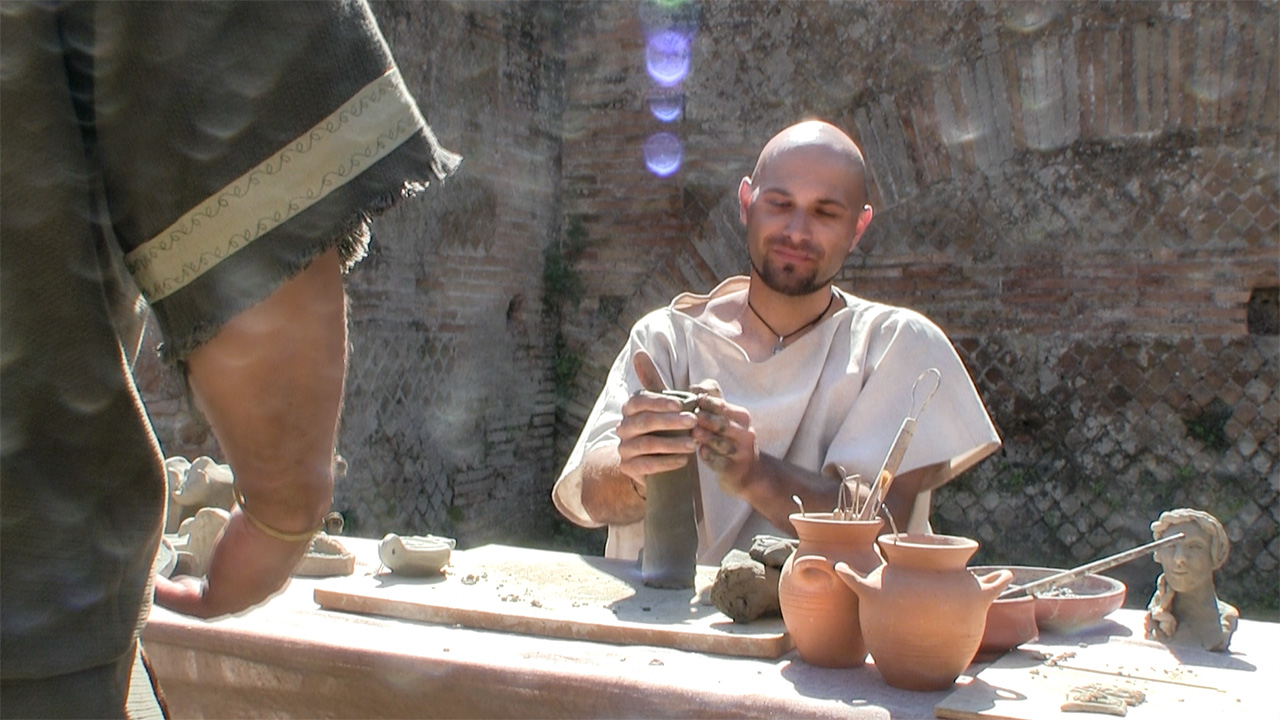
Religious Diversity in Ostia
Ostia's cosmopolitan character extended to its religious practices. The city was home to numerous temples dedicated to gods and goddesses of different cultures. The cult of Mithras, for example, found a following among the city's soldiers and merchants, while the worship of the Egyptian goddess Isis flourished in Ostia's multi-ethnic milieu. The presence of these varied religious influences underscores the city's role as a cultural crossroads.
Communal Life and Leisure in Ostia
While labor was central to Ostia's identity, so was leisure. The Baths of Neptune, a place for relaxation and socializing, allowed residents to unwind after a day's work. The city's theater echoed with laughter and applause during performances, offering a glimpse into the recreational pursuits of its inhabitants. Taverns and inns catered to travelers and locals alike, fostering a sense of community in this vibrant port town.
Archaeological excavations in Ostia Antica have unearthed a treasure trove of artifacts that provide insights into daily life. From household items like pottery and cookware to personal items like jewelry and clothing, these remnants of the past offer a tangible connection to the people who once called Ostia home.
Cerveteri - The Ancient Etruscan Civilization
As we leave behind the captivating ruins of Ostia Antica, our journey takes us deeper into the Italian countryside and further back into Rome's extensive history - to the town of Cerveteri.
Here, amidst the rolling hills and verdant landscapes, lies an enigmatic legacy — the remnants of a civilization that has long fascinated historians, archaeologists, and art connoisseurs alike: the Etruscans.
The story of the Etruscans is one of obscurity and intrigue.
Emerging in ancient Italy around the 8th century BCE, they occupied the region known as Etruria, which encompassed parts of modern-day Tuscany, Lazio, and Umbria.
The origins of the Etruscans are a subject of debate, with theories ranging from indigenous Italian roots to migration from Anatolia. Their unique language, written in a script known as Etruscan, remains only partially deciphered, adding to the mystique of this civilization.
The Etruscans’ Distinctive Culture and Society
The Etruscans were a people of singular customs and culture. They held a deep reverence for the afterlife, believing it to be an extension of earthly existence.
Elaborate burial practices, including opulent tombs and intricate frescoes, serve as a testament to their beliefs. Cerveteri, in particular, boasts a remarkable necropolis, the Banditaccia, which provides a window into the Etruscan worldview.
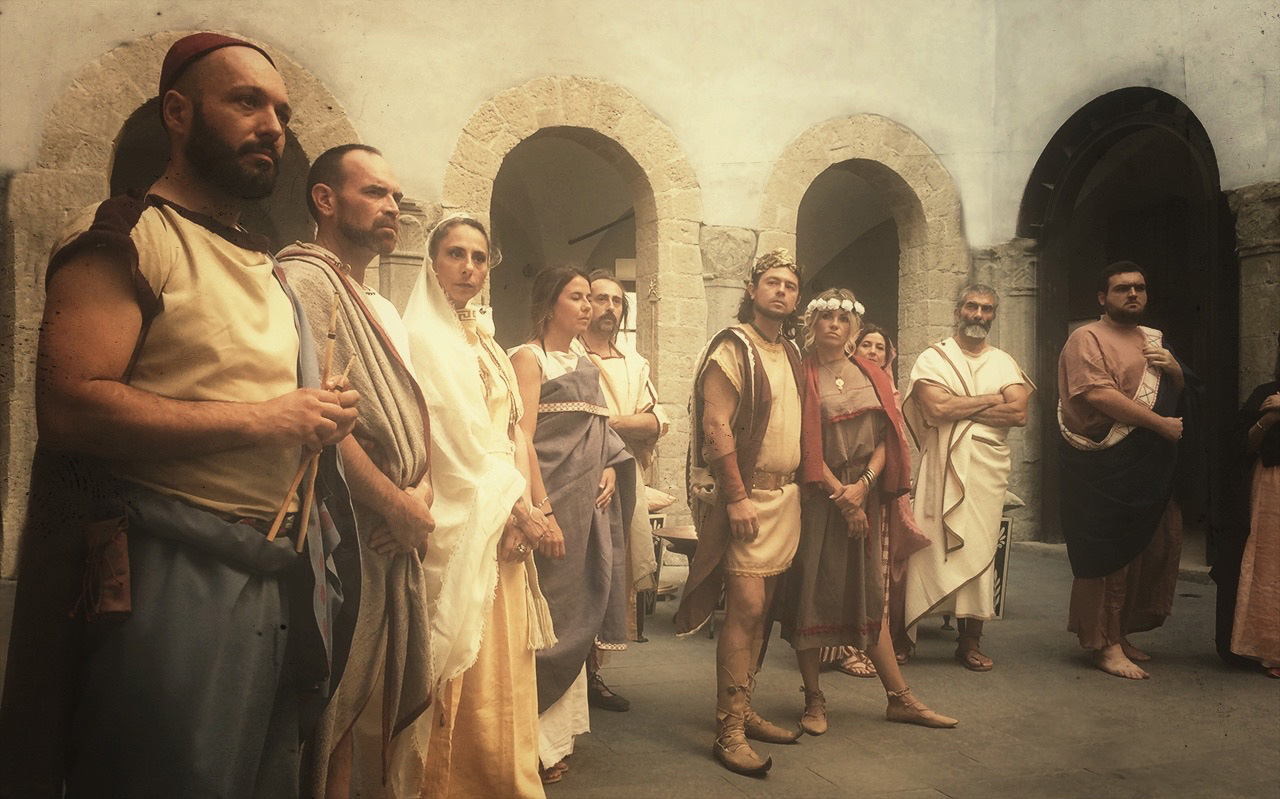
The Etruscans in Art and Craftsmanship
Etruscan art is characterized by its vivid portrayal of daily life and mythology. Their pottery, known for its exceptional quality, often featured scenes of banquets, athletics, and rituals. Intricate gold jewelry, finely crafted metalwork, and sculptures adorned with intricate detailing showcased their artistic prowess.
The Etruscans had a unique and captivating approach to commemorating their deceased, which extended to their sarcophagi. These sarcophagi were not mere stone containers but were adorned with life-sized stone or terracotta representations of the departed.
One outstanding example of this remarkable funerary artistry is the Sarcophagus of the Spouses, unearthed in Cerveteri and now proudly displayed in the Etruscan Museum of Villa Giulia in Rome.
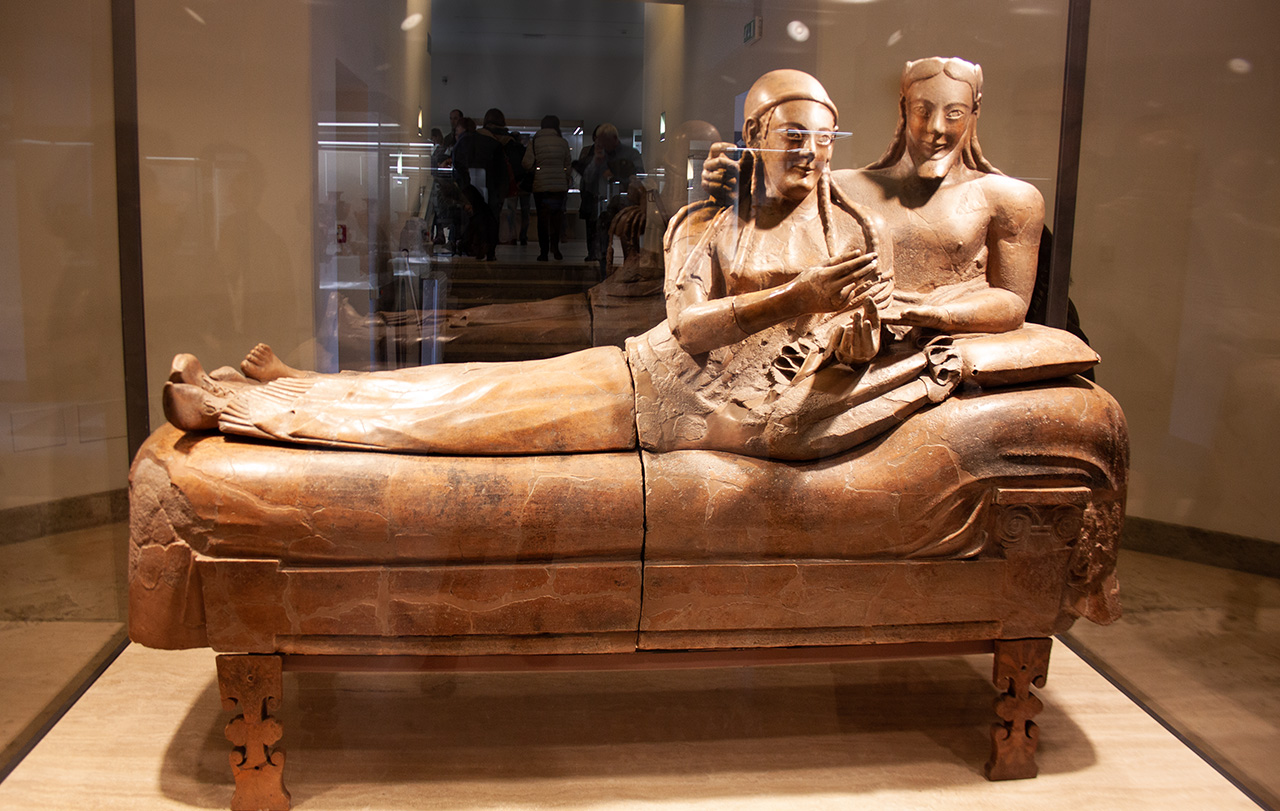
The influence of the Etruscans extended beyond their time, leaving an indelible mark on Roman civilization. Etruscan art and architecture profoundly impacted the burgeoning Roman Republic, with elements such as the use of arches, the toga, and the practice of divination adopted by the Romans.
The Banditaccia Necropolis - Where Etruscan Afterlife Meets Architectural Marvel
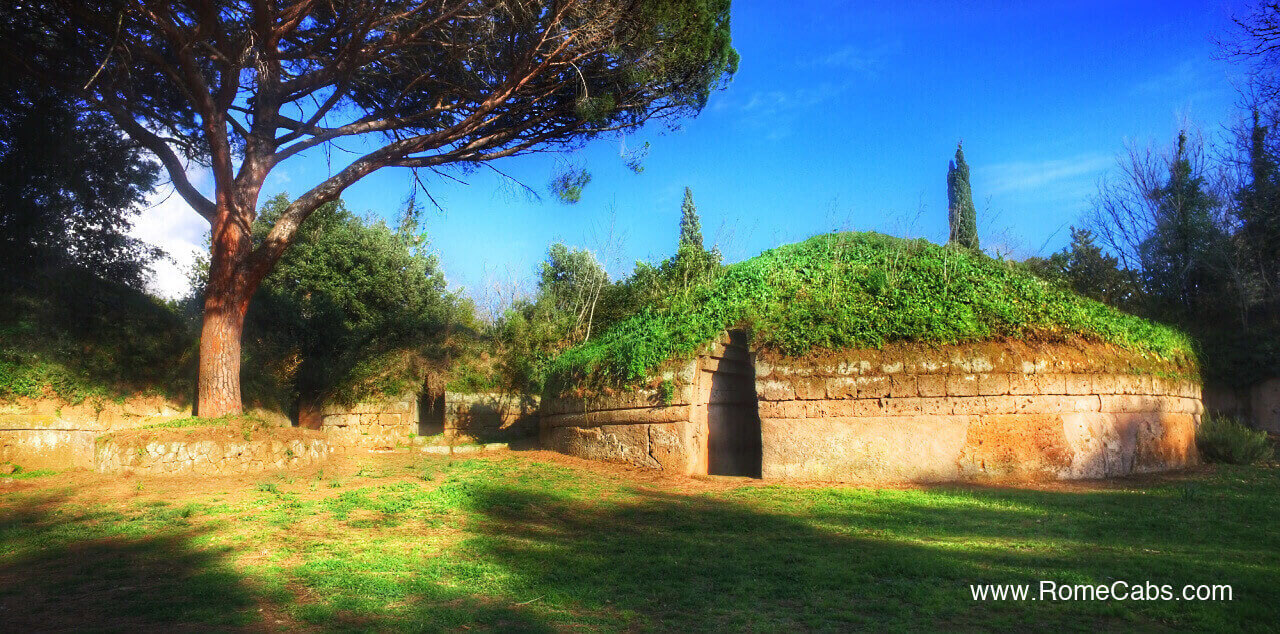
Our voyage into the depths of Cerveteri's Etruscan legacy unveils the breathtaking Banditaccia Necropolis, a sprawling testament to the Etruscan civilization that spans numerous centuries. Considered one of the most amazing Etruscan places to visit, the Banditaccia Necropolis is a UNESCO World Heritage site
At this hallowed site, you can trace the evolution of Etruscan burial practices, from the early urns designed to house cremated remains to the elaborate necropolis resembling miniature cities complete with roadways for ceremonial processions.
As you tread the ancient pathways of the necropolis, you will find yourself amidst a labyrinth of tombs, each one a silent witness to the stories of Etruscan lives etched in stone.
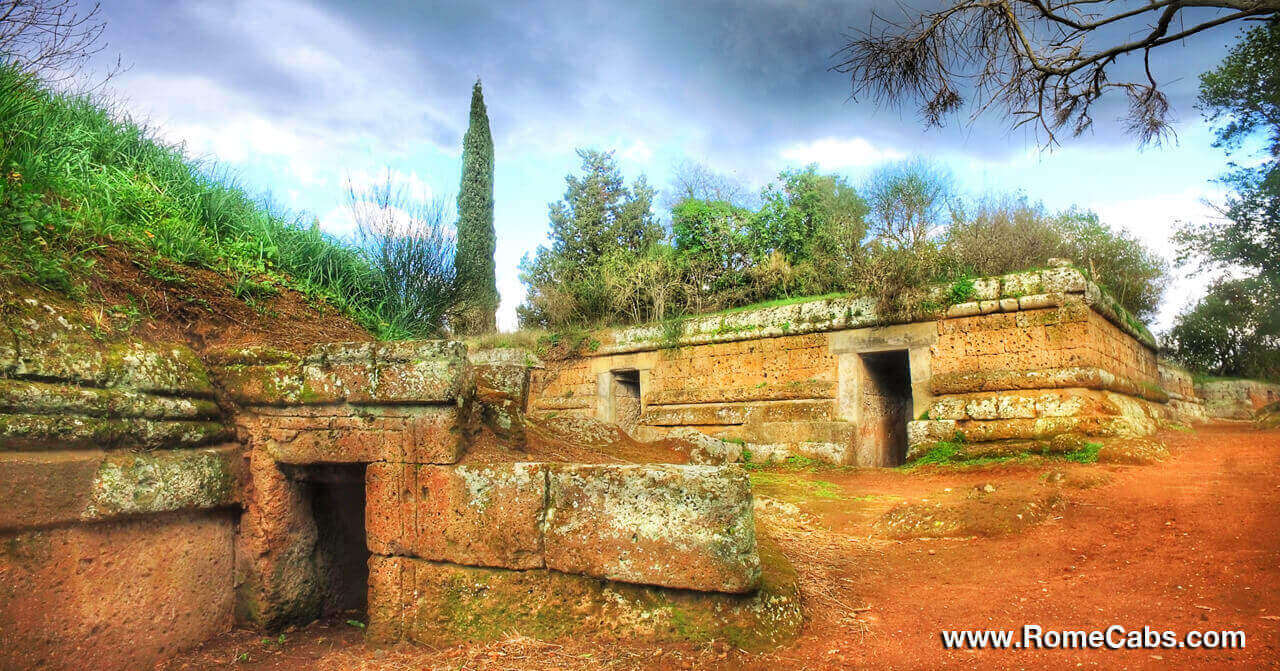
These sepulchral chambers provide us with a unique and profound understanding of the Etruscan beliefs and rituals that revolved around the afterlife. With every step, we delve deeper into the mysteries of this enigmatic civilization, unlocking the secrets hidden within the Banditaccia Necropolis.
An Etruscan City of the Dead
The Banditaccia Necropolis, dating back to the 9th century BCE, is not merely a burial site; it's a necropolis designed to mimic the world of the living.
As we traverse its winding passages and chambers, we encounter a city of the dead, complete with streets, squares, and houses. Etruscans believed that the afterlife was an extension of earthly existence, and the Banditaccia reflects this belief vividly.
Etruscan House-Like Tombs
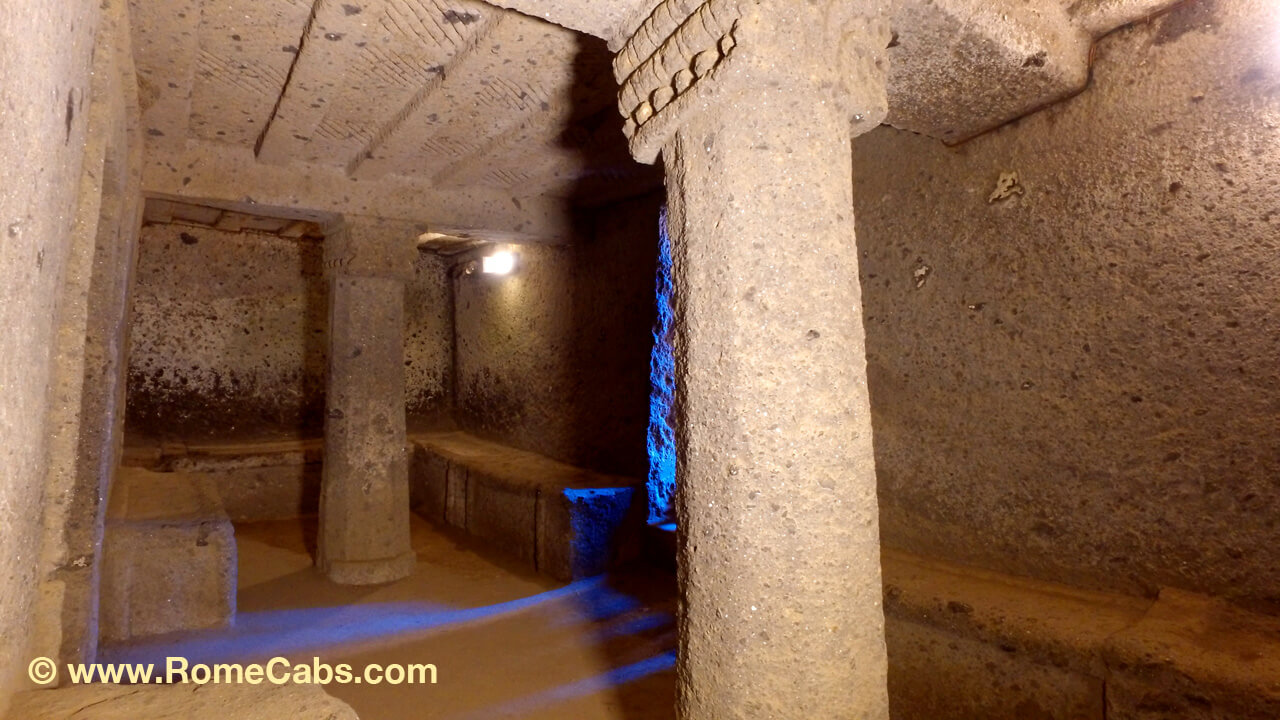
Among the most striking features of the Banditaccia are its house-like tombs. Earlier tombs were shaped like mounds, while later tombs were built in a city block system.
These ancient dwellings for the deceased are a testament to the Etruscans' unique approach to the afterlife. Each tomb was carved from the living rock to resemble a house, with multiple chambers, hallways, gabled ceilings, stone beds and furniture, and architectural details like cornices and columns. These architectural marvels served as not just a final resting place but a continuation of life in the hereafter.
Unleash your inner Indiana Jones and explore these amazing Etruscan tombs at Banditaccia Necropolis in Cerveteri.
The Influence of Cerveteri's Banditaccia Necropolis
The Banditaccia Necropolis is more than just a city of the dead and a repository of ancient tombs; it's a window into Etruscan society. The layout and design of the necropolis reveal a structured social hierarchy, with distinct burial sites for various strata of society. It serves as a testament to the Etruscans' enduring reverence for their ancestors and the belief that death was not an end but a continuation of existence.
Cerveteri's Banditaccia Necropolis invites us to step into the sacred world of the Etruscans, a realm where life and death merged seamlessly. It's a place where architecture and art tell stories of a civilization that cherished its history and viewed the afterlife as an eternal journey. As we stand amidst these ancient tombs, we pay homage to the Etruscans and their profound connection to the mysteries of existence.
Explore Ostia Antica and Cerveteri from Rome
As we conclude our journey through the portals of Ostia Antica and Cerveteri, we leave behind footprints in the sands of time. These ancient destinations, with their rich histories and captivating stories, remind us of the enduring legacy of Rome and the enigmatic allure of the Etruscans.
Whether you're a history enthusiast, an archaeology buff, or simply a curious traveler, these sites offer an unforgettable voyage into the heart of Italy's ancient past. So, when you next find yourself in Rome, heed the call of history and embark on a journey through the ages in Ostia Antica and Cerveteri.
Further, consider the exciting prospect of combining the marvels of Ostia Antica with the wonders of Cerveteri on our exclusive "Ostia Antica and Cerveteri Ancient World Tour". This all-encompassing adventure is a captivating journey through the exceptional legacies of these two formidable ancient civilizations.
This meticulously curated excursion not only unravels the extraordinary heritage of two ancient powerhouses but also introduces another historical dimension to your day as you savor a delightful lunch in the charming medieval village of Ceri. It's an opportunity to immerse yourself in the depths of history that span millennia, creating memories that will last a lifetime.
For cruisers staying in Rome pre-cruise, we offer an Ostia Antica Pre-Cruise Tour with pick up from your hotel in Rome and convenient drop off next to your cruise ship in Civitavecchia.
For additional information, we included below helpful tips for visiting Ostia Antica and Cerveteri from Rome.
10 TIPS for Visiting Ostia Antica
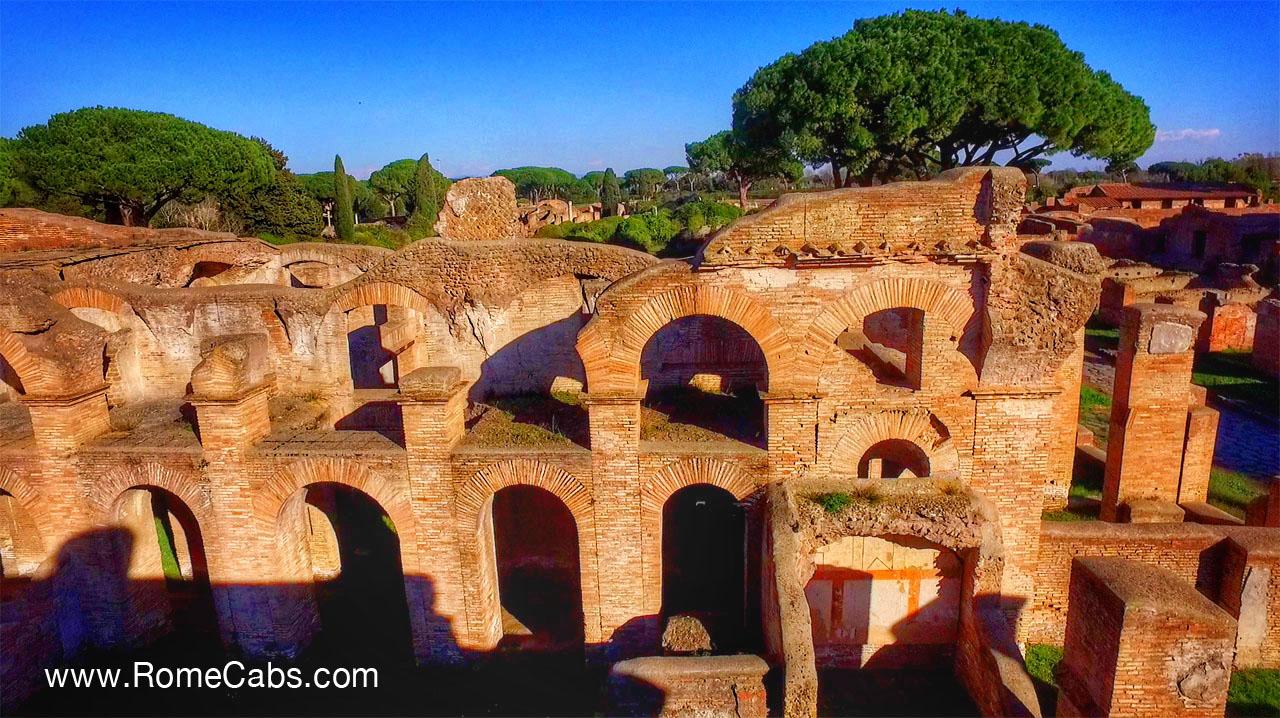
1. Plan Your Visit to Ostia Antica
Check the opening hours and days of Ostia Antica. Most museums and archaeological sites in Italy are closed on Mondays, so plan accordingly.
If you will be heading to Ostia Antica on your own using public transportation, allocate sufficient time for your visit. Ostia Antica is extensive, and you'll want ample time to explore.
2. Getting to Ostia Antica from Rome
Ostia Antica is located about 30 kilometers southwest of Rome. It can be reached by taking the Roma-Lido train (line FL5) from the Piramide station in Rome. Once you arrive at Ostia Antica station, it's a short walk to the archaeological site's entrance.
Alternatively, if you prefer to avoid the hassles of public transportation and you wish to explore more of Italy, book one of our day tours from Rome.
3. Book a Guided Tour of Ostia Antica
Consider booking a guided tour. Knowledgeable guides can provide insights into the history and significance of the site, enhancing your experience.
We can reserve a private licensed tour guide for our guests who book our Tours that include a visit to Ostia Antica.
4. Ostia Antica Tickets
You can purchase tickets at the entrance.
5. Wear Comfortable Attire when visiting Ostia Antica
Wear comfortable walking shoes, as you'll be exploring the ruins on foot.
Dress in layers and wear sunscreen during sunny days, as there's limited shade.
6. Map and Guidebook if Self Touring in Ostia Antica
Grab a map at the entrance to help you navigate the site. You can also download digital maps and guidebooks in advance.
Some guidebooks provide detailed explanations of the ruins, helping you understand their historical significance.
7. Stay hydrated while exploiting the ruins of Ostia Antica
Carry a water bottle to stay hydrated, especially during the warmer months.
While there's a cafe on-site, you might want to bring some snacks, particularly if you plan an extended visit.
8. Photography in Ostia Antica
Photography is allowed, so bring your camera or smartphone to capture the fascinating ruins.
9. Quiet Enjoyment in tranquil Ostia Antica
Ostia Antica is a serene place, and many visitors appreciate its peaceful atmosphere. Be respectful of others who are there for a tranquil experience exploring the ancient ruins.
10. Purchasing Souvenirs in Ostia Antica
There's a small gift shop where the cafe is if you wish to purchase souvenirs and books related to Ostia Antica.
Tips for Visiting Etruscan Necropolis in Cerveteri
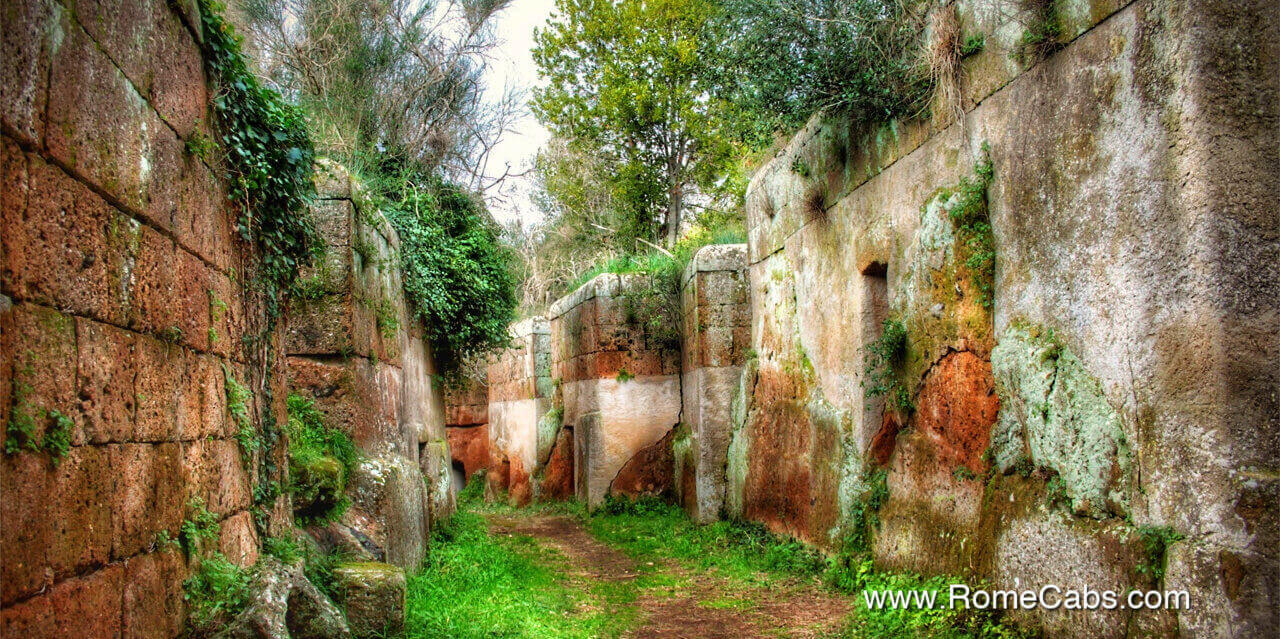
Visiting the Banditaccia Necropolis in Cerveteri is a unique opportunity to explore an ancient Etruscan burial site. Here are some tips to enhance your experience
1. Plan Your Visit to Banditaccia Necropolis in Cerveteri
Check the opening hours and days of the Banditaccia Necropolis. Like many archaeological sites, it is closed on Mondays and it may have seasonal variations in opening times.
If you will be going to Cerveteri Necropolis on your own, allocate sufficient time for your visit to thoroughly explore the site.
Double-check the opening hours of the necropolis if you plan to visit on your own, and plan your arrival accordingly.
2. Book a Day Tour from Rome to Cerveteri Necropolis
In Addition to our "Ostia Antica and Cerveteri Ancient World Tour”, we also offer a visit to Cerveteri on our Rome Countryside Splendor Tour.
Enhance your exploration through the necropolis of Cerveteri by also booking a guided tour. Knowledgeable guides can provide historical context and insights into the significance of this Etruscan necropolis. We can reserve a private licensed tour guide on our private tours from Rome.
3. Banditaccia Necropolis Tickets
Purchase your tickets at the entrance. You may also choose to purchase Combo Tickets combining a visit to the Necropolis and the Museum in Cerveteri.
4. Maps and Guidebooks if Self-Touring in Cerveteri Necropolis
Pick up site maps at the entrances if available to help you navigate the necropolises.
Consider bringing guidebooks or using smartphone apps with information about the history and significance of both sites.
5. Wear comfortable attire when exploring Cerveteri Necropolis
Wear comfortable walking shoes suitable for exploring the necropolis as you will be walking on uneven terrain, and negotiating flights of stairs to access the interior of many tombs.
Dress in layers to adapt to changing weather conditions.
6. Photography inside Cerveteri Necropolis
Photography is generally allowed, but be respectful of any specific rules or restrictions posted at the site.
Capture the remarkable tombs and surroundings while respecting the solemn nature of the necropolis.
7. Respect the ancient necropolis
Show respect for this ancient burial ground. It's essential to be mindful of the historical and cultural significance of the site.
Avoid touching the ancient structures or leaving any litter behind.
8. Stay hydrated while exploring the ancient tombs of Cerveteri
Bring water if you plan extended visits through Cerveteri’s necropolis. A refreshment facility is available on-site, although with limited options.
9. Weather Considerations
Check the weather forecast and prepare for the conditions accordingly when visiting outdoor sites like Ostia Antica and Cerveteri Necropolis. Sunscreen and hats are advisable during sunny days.
10. Nearby Attractions in Cerveteri
Cerveteri has more to offer besides the Banditaccia Necropolis. Explore the town itself, including its historic center and local cuisine.
Visit the Museum to expand your knowledge of this ancient civilization
By visiting both the Banditaccia Necropolis in Cerveteri and the Etruscan Museum inside the town, you'll embark on a captivating journey through the Etruscan civilization.
Etruscan Museum of Cerveteri
The Etruscan Museum of Cerveteri, also known as the "Museo Nazionale di Ceriti," is a cultural treasure trove located in the town of Cerveteri, not far from the Banditaccia Necropolis. This museum is dedicated to preserving and showcasing the rich heritage of the Etruscan civilization.
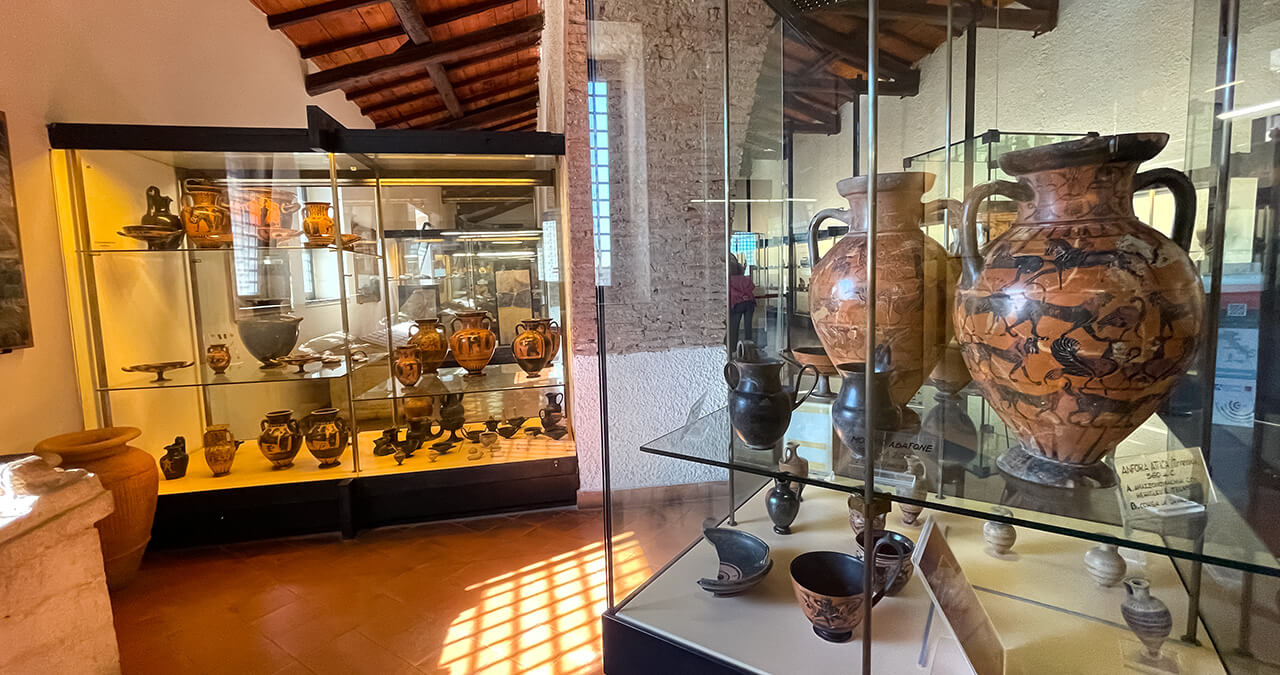
A visit to the museum complements your exploration of the archaeological site, offering a more comprehensive understanding of this enigmatic ancient culture, its customs, and its artistic achievements.
Within the museum's galleries, you'll find a diverse collection of artifacts, grave goods, and artworks that were excavated from the Banditaccia Necropolis and other Etruscan sites in the region. These exhibits include intricately crafted pottery, bronze statuary, jewelry, and tomb furnishings that provide valuable insights into the daily life, customs, and religious beliefs of the Etruscans. Particularly noteworthy are the detailed reconstructions of Etruscan tombs, offering visitors a glimpse into the burial rituals of this ancient society.
The museum is well-organized, with informative labels, multimedia presentations, and detailed descriptions accompanying the exhibits. This ensures that visitors can gain a comprehensive understanding of the significance and context of the displayed artifacts.
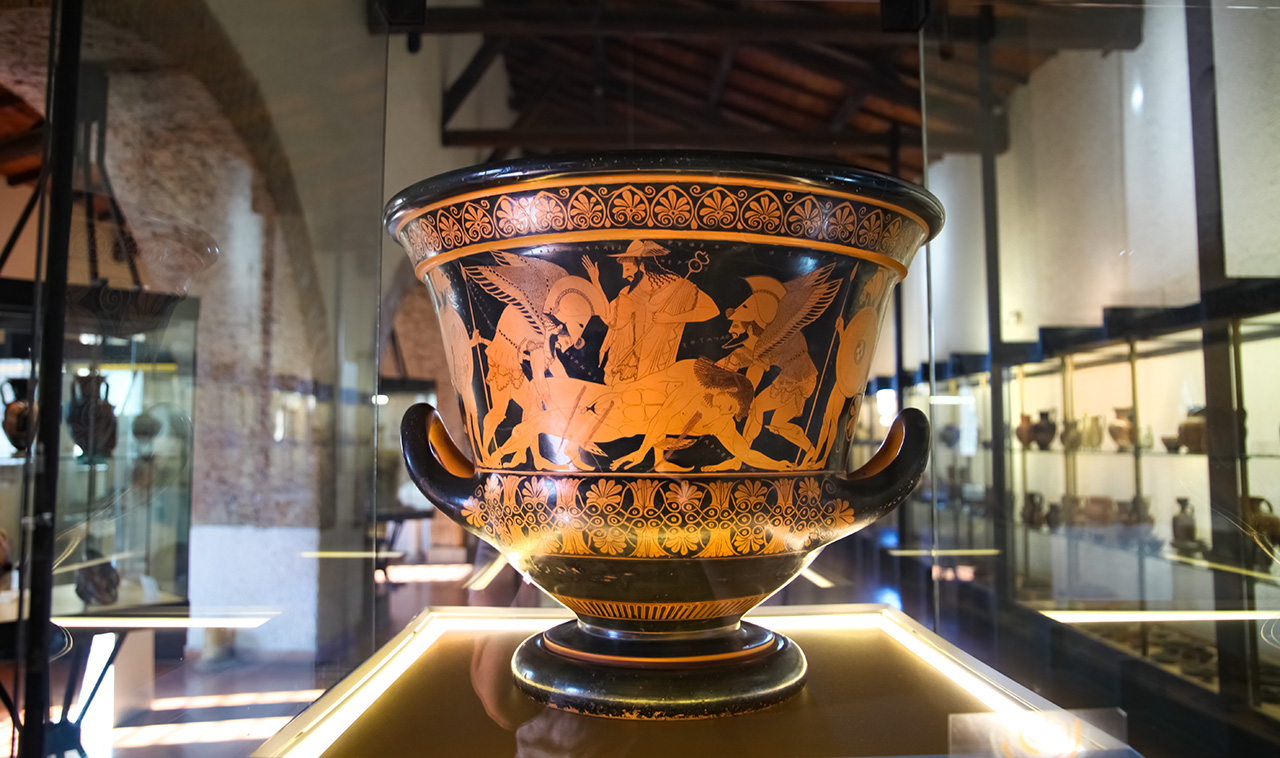
In our exploration of Ostia Antica and Cerveteri, we've traversed the realms of ancient Rome and the enigmatic Etruscan civilization. These portals to the past have unveiled stories etched in stone, from the grandeur of Ostia's Forum to the mysteries of Cerveteri's necropolis.
As we conclude our journey, we're reminded that history's tapestry is woven with threads of wonder and intrigue. Whether you're drawn to the echoes of Roman life in Ostia or the enigmatic allure of Etruscan burial traditions in Cerveteri, these sites offer a timeless connection to Italy's rich past.
So, when the call of history beckons, answer it with a voyage through the ages in Ostia Antica and Cerveteri, where the past comes vividly to life.
Thank you for choosing Stefano’s RomeCabs to be part of this remarkable journey through Italy's exquisite landscapes and rich heritage.
* Find us online also on:
- RomeCabs FACEBOOK
- RomeCabs PINTEREST
- RomeCabs TWITTER
- RomeCabs INSTAGRAM
- RomeCabs FLICKR Photo Gallery
- RomeCabs Recommended on Cruise Critic
- More RomeCabs blogs: https://romecabs.wordpress.com/
